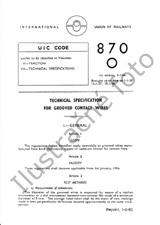Potrebujeme váš súhlas na využitie jednotlivých dát, aby sa vám okrem iného mohli ukazovať informácie týkajúce sa vašich záujmov. Súhlas udelíte kliknutím na tlačidlo „OK“.

UIC B126/DT433-1ed.
Braking Questions - Composite brake block contour optimisation to reduce equivalent conicity - Synthesis of phase 1 results
NORMA vydaná dňa 1.3.2013
Informácie o norme:
Označenie normy: UIC B126/DT433-1ed.
Dátum vydania normy: 1.3.2013
Kód tovaru: NS-1190178
Počet strán: 130
Približná hmotnosť: 421 g (0.93 libier)
Krajina: Medzinárodná technická norma
Kategória: Technické normy UIC
Anotácia textu normy UIC B126/DT433-1ed. :
Several investigations into the service performance of composite brake blocks have shown that these blocks produce a wear pattern on the wheel profile that is different from the wear pattern produced by cast iron blocks. One of the effects is the increase of equivalent conicity, which is a parameter used in assessing the running stability characteristics of a vehicle. Equivalent conicity changes relatively fast, especially on certain blocks made of sintered material.
In previous investigations the idea had arisen that the contour of the brake block had a significant impact on the wear pattern of the wheel profile and thus it was expected that modifying the block shape would have beneficial effects for the wheel profile. Therefore, in the beginning of 2009 UIC decided to start a project to optimise the shape of the brake block in order to prevent increases in equivalent conicity.
This report seeks to describe and summarise the activities carried out in the first phase of the project and draw some conclusions. The goal of the first phase was to check:
- whether the block shape did actually influence changes in the wheel profile, and
- whether bench tests were a suitable approach for the remainder of the project.
The approach consisted in conducting a certain number of bench tests with several block shapes and qualities, and compare the results with available service data.
"+
"
Name:Fragen des Bremswesens - Optimierung der Verbundstoffsohlenform zur Reduzierung der äquivalenten Konizität - Zusammenfassung der Ergebnisse von Phase 1|
Mehrere Untersuchungen der Betriebsleistung von Verbundstoffsohlen haben gezeigt, dass der Einsatz dieser Sohlen im Vergleich zu GG andere Radprofilverschleißmuster verursacht. Eine der Folgen ist der Anstieg der äquivalenten Konizität, ein Bewertungsparameter für die Laufruhe eines Fahrzeugs. Die äquivalente Konizität stieg insbesondere bei einigen geprüften Sintersohlen relativ schnell.
Frühere Untersuchungen ließen vermuten, dass die Sohlenform eine wichtige Rolle für das Verschleißmuster spielt. Man erwartete sich daher von der Änderung der Sohlenform positive Auswirkungen auf das Radprofil. Die UIC startete Anfang 2009 ein Projekt zur Optimierung der Bremssohlenform, um den Anstieg der äquivalenten Konizität zu verhindern.
Der vorliegende Bericht beschreibt zusammenfassend die Aktivitäten der ersten Projektphase und zieht einige abschließende Schlussfolgerungen. Ziel der ersten Phase war es zu prüfen, ob:
- die Sohlenform tatsächlich einen Einfluß auf die Radprofilentwicklung ausübt,
- die Prüfstandversuche eine geeignete Methode für die Weiterführung des Projekts darstellen.
Dies wurde anhand einer Reihe von Prüfstandversuchen mit verschiedenen Sohlenformen und -qualitäten und durch den Vergleich mit verfügbaren Betriebsdaten ermittelt.
"+
"
Odporúčame:
Aktualizácia zákonov
Chcete mať istotu o platnosti využívaných predpisov?
Ponúkame Vám riešenie, aby ste mohli používať stále platné (aktuálne) legislatívne predpisy
Chcete vedieť viac informácií ? Pozrite sa na túto stránku.



 Cookies
Cookies
